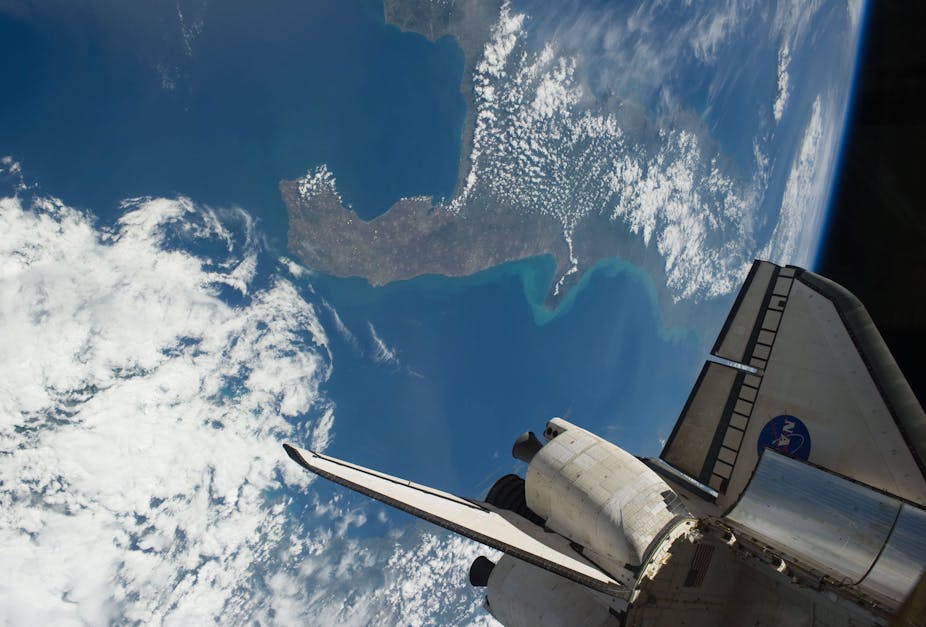All going well, the final Space Shuttle mission will be launched from the Kennedy Space Centre early on Saturday morning (AEST). This flight, being made by the Space Shuttle Atlantis, will be the 135th trip in NASA’s Space Shuttle Program and marks the end of an era.
The first Shuttle launch took place in April 1981 and in 30 years of operation the fleet of five shuttles (Columbia, Challenger, Discovery, Atlantis and Endeavour), officially known as the Space Transportation System (STS), has:
- completed more than 20,000 orbits of Earth
- docked at the International Space Station (ISS) 35 times
- supported 29 Spacelab experiments in fields such as astronomy, microgravity, radar, space physics and biology
- conducted five servicing missions to the Hubble Space Telescope
- transported hundreds of humans into space
The Shuttle program – until Saturday at least – is one of three manned spaceflight programs around the world currently in operation. The other two are the Russian Soyuz program, which will continue to transport astronauts to the ISS after the conclusion of the Shuttle program, and the Chinese Shenzhou program.
Unlike these other human spaceflight programs, the clear distinction of the Shuttle missions has been the emphasis on outreach and education, with NASA using space exploration to inspire students and the general public.
Furthermore, non-NASA personnel have often flown in the Shuttle to work on specific “payloads”, including scientific experiments or a particular piece of equipment.
The scientific and educational accomplishments of the Shuttle Program cannot be denied.
Unfortunately the destruction of the Challenger (1986) and Columbia (2003) shuttles dealt a blow to the entire premise of the program: a fleet of reusable spacecraft that would blast humans into space and ensure their safe return to Earth.
This, and the evident failure of the program to keep the costs of space travel down, has spelt the end of the Shuttle program.
But is this necessarily a bad thing?
Lawrence M. Krauss, Foundation Professor and Director of the Origins Project at Arizona State University, wrote in the April 2011 issue of Scientific American, that the discoveries made by the Hubble Space Telescope observing the far reaches of the universe have fired our imagination much more than the details of daily life aboard the ISS.
I agree with this suggestion.
The shuttles were designed for lower-orbit travel. The ISS orbits at a distance of approximately 400 kilometres from the surface of the earth.
The Hubble Space Telescope orbits Earth at a distance of approximately 600 kilometres. The furthest from Earth humans have ever travelled still remains the Moon – 1,000 times further away than the ISS.
It has already been 39 years since a human travelled that distance and walked on the Moon (1972: Apollo 17).
For those of us who lived during the Apollo 11–17 missions, the idea of space exploration is inevitably linked to humans landing on other planets and travelling to the far reaches of the solar system (and possibly beyond).
However significant, the achievements of the Space Shuttle program simply cannot rival the enormously inspiring concept of human travel to other planets.
The Shuttle program provided a platform for experimentation with materials, technologies, and the investigation of the reaction of human physiology to prolonged periods without gravity.
It is now time for all the knowledge gained from the experiments of the past 30 years to be used to plan and achieve the next stage of space exploration, one that will hopefully include deep-space human travel.
There’s only so much motivation, curiosity and scientific inspiration that can be gained by endlessly orbiting Earth – unless you do it while you’re on the moon.
Do you have stand-out memories from the Space Shuttle era? What would you like to see next? Leave your comments below.

